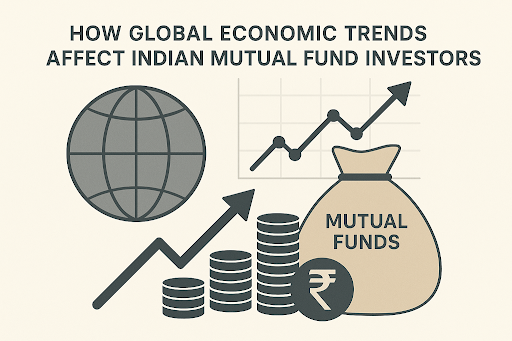How Global Economic Trends Affect Indian Mutual Fund Investors
Published 29 Apr 2025
The days when Indian markets moved in isolation are long gone. Today, global economic trends shape the very foundation of Indian mutual fund investments, often in ways that even experienced investors underestimate. While many discussions on this topic remain surface-level—focusing on interest rates, oil prices, and FII flows—let’s cut deeper into the less obvious yet game-changing global forces that dictate mutual fund performance in India. It’s common knowledge that Foreign Institutional Investors (FIIs) influence Indian equity markets. But what’s rarely discussed is how global liquidity cycles drive FII behavior and, in turn, affect Indian mutual funds. Phase 1: Global Liquidity Boom → Emerging Market Surge Phase 2: Tightening Cycle → Capital Flight from India 🔹 Advanced Insight: Investors in actively managed funds should track global M2 money supply data and Fed balance sheet trends. These indicators signal potential reversals in FII sentiment before they reflect in mutual fund NAVs. While most investors focus on RBI policy rates, the real power lies in the 10-year US Treasury yield. Here’s why: Rising US Yields → Indian debt funds struggle because higher US yields make Indian bonds less attractive to foreign investors. Falling US Yields → Encourages capital inflows into Indian debt and equity funds, boosting returns across asset classes. 🔹 Advanced Insight: The 10-year US Treasury yield crossing 4% is historically a danger zone for Indian markets. Mutual fund investors should watch this level closely. While domestic inflation is a known risk, the real disruptor is imported inflation—a silent NAV killer. Commodity-heavy mutual funds (metals, energy) benefit when global inflation spikes. Mid- and small-cap funds suffer disproportionately because rising input costs squeeze margins. Debt funds get hammered when RBI tightens policy in response to global inflation spikes. 🔹 Advanced Insight: Watch shipping freight rates (Baltic Dry Index) and global food inflation data—they often predict inflation trends before they appear in official CPI numbers. While most Indian investors obsess over the US market, China’s slowdown is the real undercurrent shaping our mutual fund landscape. If China’s economy falters → Global commodity prices fall, benefiting Indian industries like manufacturing and FMCG. Funds with exposure to these sectors surge. If China aggressively stimulates → Raw material costs rise, squeezing Indian companies' profitability and impacting mutual fund NAVs. 🔹 Advanced Insight: A major shift in China’s credit cycle directly influences Indian corporate earnings, even though it’s rarely discussed in mainstream investment circles. A strong US dollar is the stealth destroyer of Indian mutual fund performance. A rising dollar ($INR above 83) → IT and pharma funds benefit, but most equity mutual funds suffer due to FII outflows. A falling dollar ($INR below 78) → Encourages foreign inflows into Indian equity and debt mutual funds. 🔹 Advanced Insight: Keep an eye on the Dollar Index (DXY). A move above 105 often signals trouble for Indian mutual funds. Investing in Indian mutual funds today requires a global mindset. Every interest rate decision by the Fed, every supply chain disruption in China, and every move in the US bond market ripples into Indian asset prices. 🔹 The investors who thrive are those who look beyond local headlines and track these macroeconomic forces. The next time you review your mutual fund portfolio, ask yourself: Am I thinking like a global investor in a connected world?Advanced Insights for the Seasoned Investor
1. The Hidden Impact of Global Liquidity Cycles on Indian Mutual Funds
When central banks (primarily the Fed and ECB) keep liquidity high, global capital hunts for higher returns. This fuels inflows into emerging markets, driving Indian equity mutual funds to outperform.
When global liquidity contracts (as seen during Fed rate hikes), FIIs dump Indian stocks, leading to corrections. Mutual funds with high exposure to FII-heavy stocks—such as large-cap IT and financials—take a direct hit.2. US Bond Yields: The Silent Dictator of Indian Debt and Equity Funds
3. The Real Inflation Shock: Why Indian Mutual Funds Are More Vulnerable Than You Think
4. China’s Economic Moves: The Black Swan for Indian Mutual Funds
5. The Dollar Wrecking Ball: How Currency Moves Reshape Mutual Fund Returns
Final Thought: Thinking Like a Global Investor




